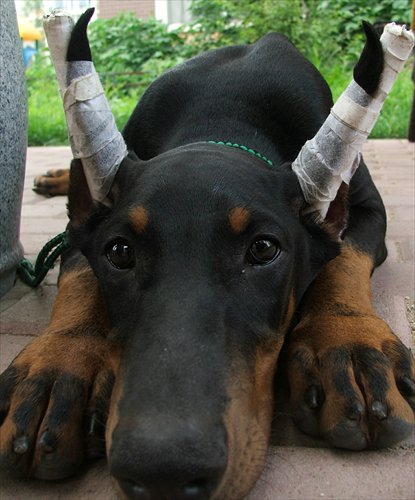Plastic surgery on pets
Vets caution that animals should be left alone and their rights protected

A dog recovers from ear cropping surgery. Photo: CFP
The 3-month-old Doberman Pinscher lay hopelessly on the operating table. The vet administered the anesthesia. In the next hour, the dog lost consciousness and the vet began cutting his ears, making them pointy as the dog's owner had requested.
"After he woke up, he whimpered for several minutes," said the owner, 29-year-old Yao Kun who works in the automobile industry. "The dog is used to competing in beauty contests, so I have to take him to receive plastic surgery," said Yao. This is not the first operation the Doberman Pinscher has undergone, having had his tail docked just after he was born.
"The operation cost over 1,000 yuan ($163). I gave him the best anesthesia. Dogs can endure the pain better than humans. I believe he doesn't suffer that much," he said.
Like Yao, there are a growing number of people who prefer to give their pets plastic surgery to achieve better looks. Back in July, the Chongqing Economic Times reported that a dog underwent double-fold eyelid and eye enlarging surgeries in South Korea, which brought the topic of plastic surgery on pets to the public's attention.
Shang Taicheng, a vet at Beijing Sicheng Animal Hospital, said that popular plastic surgery procedures for pets include declawing tail docking, ear cropping, and the dying of fur.
"People do this out of their own personal will, but it is against the animal's will. Owners want their pets to conform to their standard of beauty," said Shang. "For example, many people took their Schnauzer dogs to the vet to make their ears more pointing, because they believe it makes their dog look more lively. Another common procedure is to cut the tail of a Shih Tzu Bichon to make it look more cute and pleasing to the eye."
Shang noted that several years ago, many pet vendors would dye pets to change the color of their fur. "I once saw a white cat that was dyed black and yellow. They dye pets so they will sell at a good price," he said.
According to Shang, if pet owners want to do tail docking, it is better for them to do the surgery before the pet reaches 7 days old.
"At that time, a pet can't feel much pain and it will quickly recover. While for ear cropping, pet owners need to wait for at least three months, because it's hard to estimate how big the ears will grow to be," said Shang. He said they perform less than 10 cosmetic surgeries on pets each month.
Shang stressed that as a vet, he is totally against cosmetic surgery on animals, which he considers immoral. "However, due to the overwhelming influence of the market economy, plastic surgery for pets is unavoidable," Shang said.
Mary Peng, co-founder and CEO of the International Center for Veterinary Services, noted that for a certain breed of dog, like Doberman Pinscher, people have a long tradition of cutting off their tails and ears to make them look a certain way.
"That's not how this breed of dog is supposed to look. We don't do this surgery anymore because it's not considered necessary. It just alters the appearance. More and more countries in the world are starting to make this kind of plastic surgery illegal," said Peng. She also noted that there are also people giving Tibetan Mastiffs plastic surgery to remove the wrinkles on their forehead.
"[Tibetan Mastiffs] that have had surgery can command a higher price when they're used for breeding. But none of the plastic surgery is essential for the health of the animal," Peng said, adding that a surgery can sometimes carry a deadly risk to pets.
The Beijing News reported in March that a man's Tibetan Mastiff died during a face lift operation.
Peng expected that in the future, plastic surgeries on pets will be abolished as more and more people are becoming concerned about animal welfare.
"Animals should be left alone. The plastic surgery doesn't benefit the animals," she said.